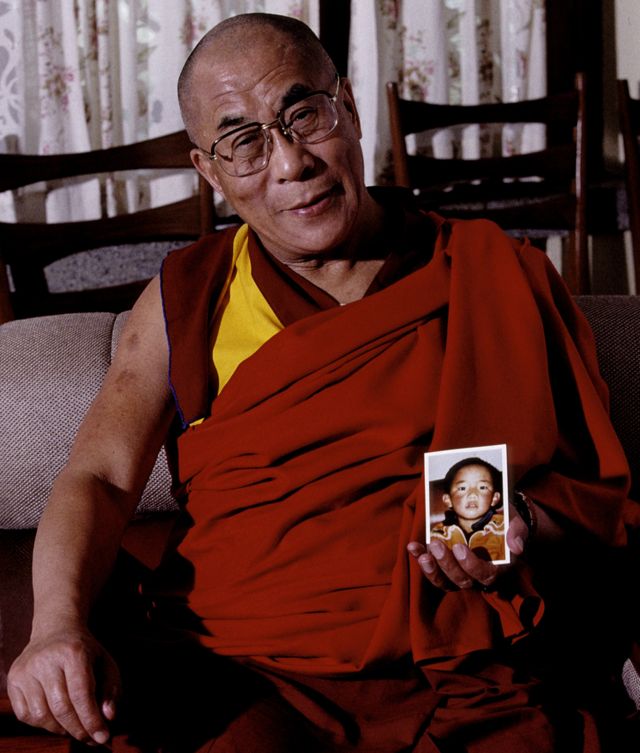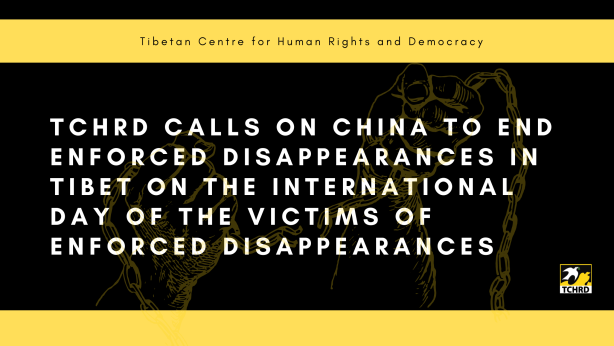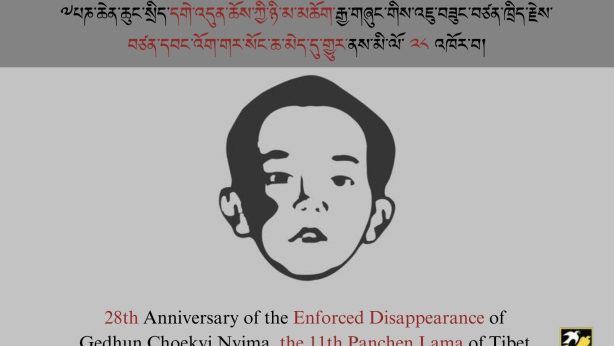29 years since the enforced disappearance of Tibet’s Panchen Lama by the Chinese government

On the 29th anniversary of Tibetan spiritual leader Gedhun Choekyi Nyima’s enforced disappearance, the Tibetan Centre for Human Rights and Democracy strongly condemns the Chinese government’s continued failure to provide information on his whereabouts and reiterates our calls for the authorities to reveal the truth. Despite extensive efforts and calls from the global Tibetan community, international governments and the United Nations for more than two decades, the Chinese government has continued to ignore their calls leaving a deep void in the hearts of the Tibetans inside and outside Tibet.
On 14 May 1995, His Holiness the Dalai Lama formally recognised Gedhun Choekyi Nyima, a young boy from Nagchu (Ch: Naqu) Prefecture in Tibet Autonomous Region (TAR), as the reincarnation of the 10th Panchen Lama and bestowed upon him the religious name Tenzin Gendun Yeshi Thinley Phuntsok Pal Sangpo. However, the following day, the Chinese government issued a statement rejecting the Dalai Lama’s selection of the young boy as illegitimate. This stance, though, starkly contrasts with the traditional customs of Tibetan Buddhism, particularly the Gelugpa sect. Historically, reciprocal recognition between the Dalai Lama and the Panchen Lama has been customary, underscoring the profound spiritual significance.
In a tragic turn of events, on 17 May, the young boy and his parents were abducted from their home in Lhari County in Nagchu(Ch: Naqu) Prefecture in Tibet Autonomous Region (TAR). Since that fateful day, they have vanished without a trace, their whereabouts remaining in mystery.
Chadrel Rinpoche, a Tibetan lama who defied the odds to champion Tibetan spiritual autonomy

The Chinese Communist Party appointed Chadrel Rinpoche, a close disciple of the previous Panchen Lama, as the head of the Search Committee for the 11th Panchen Lama by the Chinese government. Despite his appointment, he remained loyal to his inherited spiritual legacy. Concerned about Chinese interference, he persistently corresponded with the Private Office of the Dalai Lama, including letters through diplomatic channels, one via the Chinese embassy in New Delhi on 30 January 1989, which was published by the Tibet Daily on 31 January 1989, and another through the Tibetan government delegation when they visited Beijing. On 17 July 1993, a petition was received at the Private Office of His Holiness the Dalai Lama through an official channel via Beijing urging him to swiftly discover and recognise the rightful reincarnation according to the centuries-old tradition.
Due to his persistent correspondence and appeals to His Holiness for the prompt discovery of the reincarnation, he faced threats of removal from the committee by a pro-Chinese state puppet, Mr. Sangchen Lobsang Gyaltsen.
In March 1995, at a CPPCC meeting in Beijing, Chadrel Rinpoche and Champa Chung-la, serving as Secretary of the Search Committee, vehemently opposed China’s attempt to impose its own choice for the Panchen Lama. Consequently, upon its conclusion, Chadrel Rinpoche faced harassment and was virtually placed under house arrest. Chadrel Rinpoche was arrested in Chengdu on 17 May and transported back to Beijing. There, he was arbitrarily detained and put under house arrest for communicating with His Holiness the Dalai Lama, in exile regarding the choice of reincarnation. On 21 April 1997, Rinpoche was later sentenced to six years’ on charges of “plotting to split the country” and “leaking state secrets” and three years of deprivation of political rights.
On 14 July 1995, the local Religious Affairs Bureau in Shigatse issued an official decree stripping Chadrel Rinpoche and other leading lamas of Tashilhunpo Monastery of their positions replaced by eight new pro-Chinese leaders, including Sangchen Lobsang Gyaltsen, whom, as aforementioned, China had been eyeing for a long time as a replacement for the new head.
China’s appointment of the puppet Panchen Lama
On 29 November 1995, the Chinese government appointed Gyaltsen Norbu as its chosen candidate for the position of the 11th Panchen Lama, driven by political motives. This move sparked widespread criticism and controversy, especially among Tibetans in Tibet. In response, the Chinese state imposed a draconian curfew to suppress dissent and potential protest. The process of enthronement and maliciously planned recognition can be detailed in the testimony of Arjia Rinpoche, who managed to flee into exile because he could not just tolerate the appointment of the Chinese State Party Panchen Lama.
A year later, in May 1996, the People’s Republic of China admitted to holding Gendhun Choekyi Nyima “at the request of his parents,” citing concerns about potential abduction by ‘separatists’ and threats to his safety.
The last information on Panchen Lama’s condition became available on 6 September 2015 when Norbu Dhondup, an official from the United Front Work Department of Tibet Autonomous Region (TAR), responded to questions from the media that Panchen Lama was ‘living a normal, happy life, receiving a good cultural education, and ‘does not want to be disturbed.’
The refusal to provide photographs or verifiable evidence on his condition and whereabouts positively identifying him as Gendhun Choekyi Nyima, along with the denial of independent and just access to him and his family, raises significant concerns regarding the purported claim by the Chinese state on their claim of him living every day, happy life and receiving a good cultural education and that he ‘does not want to be disturbed.’
Such lack of transparency is designed to deflect inquiries from the international community on the enforced disappearance of one of Tibet’s most influential spiritual leaders, second in hierarchy only to the Dalai Lama in the Tibetan Buddhist pantheon of Lamas. The apparent economic incentives offered to Tibetans to even welcome their appointed Panchen with financial rewards such as 100 Chinese yuan further underscore the insecurity surrounding the imposition of their puppet Panchen and is implicative of a lack of genuine acceptance of the puppet Panchen by Tibetans inside Tibet.
The Panchen Lama and the Dalai Lama recognise each other, and the kidnapping of the Panchen Lama hence is a long-term plan of the Chinese government to sabotage the succession process of the next Dalai Lama.
The continued secret detention of the Panchen Lama constitutes a grave violation of human rights. It is a blatant act of enforced disappearance, recognised as a serious international crime violating multiple human rights and fundamental freedoms enshrined in the Universal Declaration of Human Rights and other major international human rights treaties.
Despite claims by the Chinese Communist Party asserting that only criminals are put in incommunicado detention, house arrest or jail, the deletion of the Tibetan political prisoner database suggests a broader pattern of repression and sheds light on their attempt to hide their unjust sham trials against human rights advocates, influential leaders and Living Buddhas of Tibet.
At 35, the Panchen Lama does not require Chinese protection to lead a normal life. Instead, absence of any and all information on him in evidence of the Chinese government’s effort to undermine Tibetan religious beliefs and cultural values through distortion and control of religious aspects of Tibetan life, aiming for long-term sinicization, a process met with growing fear among Tibetans due to increasingly repressive measures and laws, coupled with extensive patriotic education.
The Tibetan Centre for Human Rights and Democracy (TCHRD) urgently appeals to the Chinese government to end the enforced disappearance of the 11th Panchen Lama and allow an independent fact finding delegation to ascertain the conditions of 11th Panchen Lama Gendun Choekyi Nyima and his family members.


